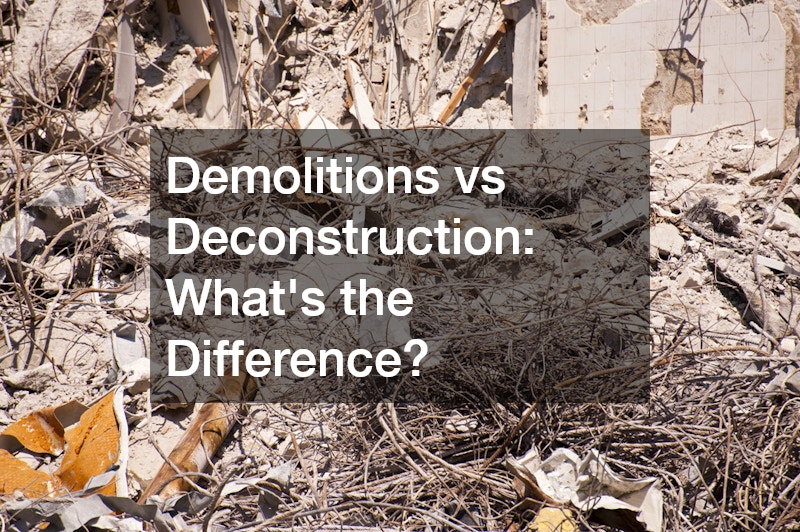When it comes to removing buildings to make way for something new, two terms often get thrown around interchangeably— demolitions and deconstruction. While they both involve the dismantling of structures, their processes, impacts and outcomes differ significantly.
Understanding the key differences can help property owners, builders and developers make informed decisions that align with their project goals, environmental values and budgets.
The Basics of A Demolition
It’s the traditional and most widely recognised method of structural removal. This process involves the rapid destruction of a building using heavy machinery, explosives or mechanical equipment like bulldozers, wrecking balls and excavators. It’s favoured for its speed and efficiency, especially when time and cost constraints are top priorities.
In most cases, a demolition results in large amounts of mixed debris—timber, bricks, concrete, metal and glass—piled together without much regard for separating reusable materials. While some recyclable items may be salvaged post-demolition, the primary goal is to clear the site quickly and prepare it for redevelopment.
Whether it’s a residential home or a multi-storey commercial building, a demolition is often the go-to choice when structures are unstable, hazardous or beyond repair.
What Is Deconstruction?
Deconstruction, on the other hand, is a methodical and environmentally conscious approach to dismantling a building. Instead of knocking everything down at once, structures are taken apart piece by piece with the intent of salvaging as many materials as possible. Doors, windows, timber beams, bricks, roofing sheets and even fittings can be recovered and reused or sold.
This process requires more time, labour and planning than a traditional demolition. However, the benefits of deconstruction are far-reaching. Not only does it significantly reduce landfill waste, but it also offers cost savings through the resale of salvaged materials and potential tax deductions for donated items.
Deconstruction is particularly appealing to homeowners and developers committed to sustainable building practices, aiming to reduce their environmental footprint and support the circular economy.
Environmental Impact
One of the most important distinctions between demolition and deconstruction lies in their environmental impact. Demolition will typically generate large volumes of waste, much of which ends up in landfills. Even with increasing efforts to improve recycling rates, the mixed nature of demolition debris often limits what can be effectively separated and reused.
In contrast, deconstruction minimises waste from the outset. By sorting materials during the dismantling process, it maximises the reuse potential and reduces the need for new raw materials. This not only conserves natural resources but also reduces carbon emissions associated with manufacturing and transporting new building components.
Cost Considerations
At first glance, demolition may seem like the more budget-friendly option due to lower labour costs and shorter project durations. However, these immediate savings can be offset by landfill fees, environmental levies and the missed opportunity to recover value from reusable materials.
Deconstruction, while more labour-intensive, can lead to long-term savings, especially when factoring in the resale value of salvaged items or the tax benefits from donating usable goods. For projects that are not time-sensitive, this method can prove both financially and environmentally rewarding.
It’s also worth noting that a hybrid approach—partial deconstruction followed by demolition—can strike a balance between cost-efficiency and sustainability.
Project Suitability
Not all buildings are suitable for deconstruction, and not all demolitions are wasteful. The choice between the two approaches depends heavily on the structure’s condition, the materials used, the project timeline and the client’s priorities.
Older buildings constructed with high-quality hardwoods, handmade bricks or vintage fixtures often yield greater value when deconstructed. Meanwhile, structures that pose safety risks or are built with hazardous materials such as asbestos may necessitate immediate demolition for safety and compliance reasons.
Property owners should work with qualified contractors who can assess the building and advise on the most appropriate course of action based on site-specific conditions.
Regulatory Requirements in Australia
In Australia, regulations surrounding demolition and deconstruction are becoming more defined, especially as state governments push towards waste reduction targets. Many councils now require demolition plans to include waste management strategies, and some offer incentives for recycling or reuse efforts.
Licensing and permits are mandatory for both processes, with strict safety and environmental standards to follow. Engaging licensed professionals ensures that all activities are compliant with Work Health and Safety (WHS) laws and environmental guidelines.
Making the Right Choice

While both demolition and deconstruction serve the same fundamental purpose—removing a structure to make way for something new—their methods, impacts and philosophies differ markedly. Demolitions offer speed and simplicity, often ideal for urgent or hazardous projects. Deconstruction promotes sustainability and resource recovery, appealing to those who value eco-conscious construction.
Ultimately, the best approach depends on your specific goals, timeline and budget. By understanding the differences between these methods, property owners and developers can make informed choices that align with both their practical needs and environmental values.


